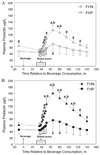Breastfeeding and prolactin levels in lactating women with a family history of alcoholism
- PMID: 20403941
- PMCID: PMC2980825
- DOI: 10.1542/peds.2009-3040
Breastfeeding and prolactin levels in lactating women with a family history of alcoholism
Abstract
Objective: Many motivated new mothers fail to reach public health goals for breastfeeding, highlighting the need to identify risk factors. Because having a family history of alcoholism is associated with blunted prolactin responses to an alcohol challenge in nonlactating individuals, this study aimed to identify associations in family history of alcoholism, prolactin, and breastfeeding behaviors in lactating women.
Methods: This was a 2-day experimental study that used within-subject alcohol or control beverage consumption and between-subject family history of alcoholism factors. The participants were non-alcohol-dependent lactating women; 7 were family history-positive (FHP) for alcohol dependence, and 21 were family history-negative (FHN). Consumption of 0.4 g/kg alcohol or nonalcoholic beverage occurred in separate randomized sessions, followed by use of a breast pump. Basal and suckling-induced prolactin, blood alcohol concentrations, milk yield, self-reported drug effects, neophobia, and breastfeeding patterning were measured.
Results: Although no group differences in alcohol pharmacokinetics were detected, FHP women exhibited blunted prolactin to breast stimulation after drinking the control and alcohol beverage and felt more of the stimulant-like effects of alcohol than did FHN women. FHP women reported more frequent daily breastfeeding than did FHN women.
Conclusions: This is the first evidence that family history of alcoholism is associated with a blunted magnitude, rapidity, and duration of the prolactin response to breast stimulation and an alcohol challenge in lactating women. More frequent breastfeeding by FHP women suggests behavioral compensation for perceived and/or actual poor lactation. Alcohol did not enhance lactational performance, further disputing the lore that alcohol is a galactagogue.
Figures

 ) 35 to 51 minutes after the consumption of the beverage (time point = 0). a Values within each test session that are significantly different from their respective baseline values (P < .05). b Values that are significantly different from similar time points between FHP and FHN women (plasma levels; P < .05). To convert prolactin in micrograms per liter to picomoles per liter, multiply by 43.5.
) 35 to 51 minutes after the consumption of the beverage (time point = 0). a Values within each test session that are significantly different from their respective baseline values (P < .05). b Values that are significantly different from similar time points between FHP and FHN women (plasma levels; P < .05). To convert prolactin in micrograms per liter to picomoles per liter, multiply by 43.5.

References
-
- Dewey KG, Nommsen-Rivers LA, Heinig MJ, Cohen RJ. Risk factors for suboptimal infant breastfeeding behavior, delayed onset of lactation, and excess neonatal weight loss. Pediatrics. 2003;112(3 pt 1):607–601. - PubMed
-
- Rasmussen KM, Kjolhede CL. Prepregnant overweight and obesity diminish the prolactin response to suckling in the first week postpartum. Pediatrics. 2004;113(5) Available at: www.pediatrics.org/cgi/content/full/113/5/e465. - PubMed
-
- Freeman ME, Kanyicska B, Lerant A, Nagy G. Prolactin: structure, function, and regulation of secretion. Physiol Rev. 2000;80(4):1523–1631. - PubMed
Publication types
MeSH terms
Substances
Grants and funding
LinkOut - more resources
Full Text Sources
Medical

